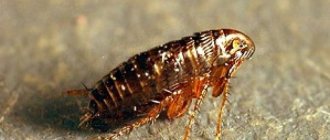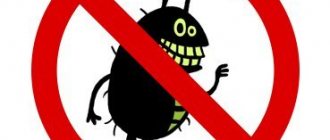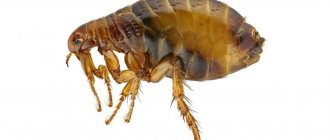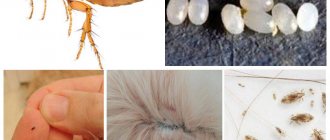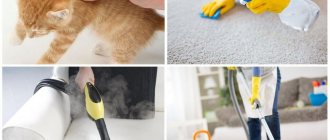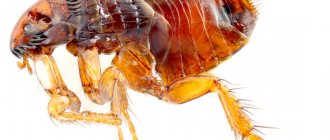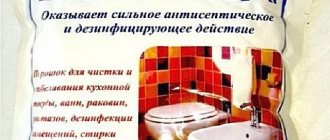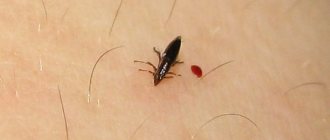People try to get rid of fleas in different ways - both by using home remedies and using chemicals. But the effect quickly wears off, and the fleas breed again. Why is that?
It’s not just the product that influences the results. It is important to understand the biology of parasites and why they appear.
In this article, we will give advice to homeowners on where to start fighting earth fleas and how to finish it correctly, taking into account all the nuances, in a comprehensive manner. Our recommendations on how to get rid of fleas are as effective as possible; they are used in their practice by experienced exterminators.
Description of earthen fleas
Ground fleas got their name because of their habitat. They live in the ground, in the summer - in the upper soil layers, in the winter they descend deeper to lay eggs. The color of the parasites has dark brown shades, the body length is no more than three millimeters. They are quite difficult to detect with the naked eye. If you suspect that fleas have settled in the house, place a white sheet of paper, for example, on a chair or other upholstered furniture. Soon small black dots appear on the leaf; these are parasites.
Earth fleas are offensively jumpy. A height of 50 cm is not an obstacle for them. Parasites easily jump onto the body of an animal or person and are held on to it with the help of a huge number of bristles.
Fleas are considered long-lived among household insects. They live up to two years and produce up to five hundred offspring over the course of their life.
The adult female lays eggs only after feeding on blood. About 48 hours after the meal, 40-50 eggs appear. On the tenth day (possibly earlier, depending on conditions and environment), a larva is born from each egg. The larvae hide in dark crevices and corners because they are afraid of daylight. After one to two weeks, the larva creates a protective cocoon around itself, in which it stays for up to two hundred days. Then a young flea emerges from the pupa.
Habitats
Ground fleas live in the soil . In winter, they bury themselves 15-20 cm into the ground and pupate. With the onset of warmth, they leave their cocoons and move to the upper layers of the soil. An increase in their numbers is observed when it rained for some time, and then the heat came. High air temperatures and high humidity are the most suitable conditions for these insects. Adult parasites begin to search for a victim.
Fleas don't only live in the ground. They can be found and reproduce in human homes. They live in rooms with high humidity. They attack apartments on the first floors. They are especially common in homes where people neglect sanitary standards.
Good hiding places for them:
- a pile of clothes;
- cracks in the floor;
- folds of upholstered furniture;
- long carpet pile, etc.
In addition, fleas choose outbuildings. They live in animal bedding and places where old things are stored.
Why are earth fleas dangerous?
Earth fleas can cause a lot of inconvenience, bordering on danger. They turn regular home life into hell, especially at night. A person cannot get enough sleep because he is constantly exposed to flea bites. This leads to stress, irritation, decreased performance and overall quality of life.
Pets infected with fleas begin to suffer from the consequences of bites, constantly itch, and bring fleas into the house on their fur.
Fleas bite because of their parasitic lifestyle, and only females do this. It is the females who need to receive a large amount of blood protein, which she needs to bear and feed new offspring of fleas.
Family Rod-like geniculates
Berytidae is a small family of about 170 species, of which about 40 species live in Europe. They are distinguished by geniculate antennae, a narrow long body and long thin legs. They live mainly in temperate climate zones.
Berytinus clavipes
Berytinus hirticornis Gampsocoris culicinus
Metacanthus annulosus
Neides aduncus
Neides tipularius
How do fleas get into a house or apartment?
Uninvited guests enter the house from attics and basements. If these parts of the house are in poor sanitary condition, then infestation with parasites is simply inevitable. Dust and high humidity are the best conditions for fleas to live and reproduce.
Often fleas are “picked up” in public places, for example, at a train station, and brought into the house on clothes or shoes.
So, the ways fleas enter the house:
- on the fur of pets;
- on a person’s shoes and clothing;
- from unsanitary places at home;
- from neighboring houses and plots;
- on the body of rodents (mice, rats).
Fleas are happy to stay in such hidden places where it is warm and humid. This is their native element and they find it under baseboards, in carpets, in upholstered furniture, under linoleum, in plush toys.
Family Podkorniki
Small and medium-sized bugs with a flat body, black or brown in color. These bugs live on tinder fungi, on the bark and under the bark of trees, in the passages of bark beetles, and in the leaf litter under trees.
Aneurus avenius Aneurus laevis
Aradus betulae Aradus cinnamomeus Aradus signaticornis Mezira tremulae
Earth flea bites: what they look like, why they are dangerous
Fleas bite and cause a lot of problems. A red spot with a diameter of up to 2 cm forms at the site of the bite. Depending on the reaction of the human body, the spot may have a swollen appearance.
The bite site is very itchy. Fenistil gel or its analogues will help eliminate itching. It is especially important to quickly help children because, unlike adults, they cannot cope with the strong desire to scratch an itchy bite.
To avoid infection from strong scratching, it is necessary to treat the skin with an antiseptic. Miramistin and chlorhexidine are suitable.
Multiple bites can cause anaphylactic shock. Therefore, if fleas attack, you need to urgently consult a doctor for medical help.
Allergy
In people prone to allergies, flea bites can cause pulicosis. Children are especially susceptible to allergic reactions. Severe irritation and itching occurs at the site of the bite. If the child has white skin, then you can notice purple - a reaction to a flea bite in the form of subcutaneous hemorrhage.
Inflammation
If the flea was a carrier of some disease, then inflammation and an abscess occurs at the site of the bite. It should be immediately treated with iodine and consult a doctor for medical help.
Diseases transmitted through a bite
Earth flea bites are dangerous. They carry:
- encephalitis (inflammatory disease of the brain);
- plague (an acute infectious disease affecting almost all organs, accompanied by the development of sepsis);
- typhus (an intestinal infection accompanied by fever and mental disturbances);
- hepatitis (viral liver disease);
- salmonellosis (intestinal infection).
Fleas are able to “reward” even helminths (Toxocara, tapeworms).
Family Groundbugs (Groundbugs)
Insects, 1-13 mm long. Within the family Terrestrials vary greatly in shape and less so in color. Bugs of dark colors predominate, although they are also found with contrasting colors: black-red, black-yellow, etc. Ground bugs are widespread throughout the world, including polar species. They feed on mature plant seeds. Let's look at some types of earthen bugs.
Nysius groenlandicus is the northernmost species of bedbugs; it lives in Greenland, Chukotka, and the northern part of America. Body length is about 5 mm, grayish-brown in color. They feed mainly on plant seeds.
Kleidocerys resedae are bedbugs that live primarily in the northern hemisphere. Body length is about 5 mm. They live on bushes and trees (alder, birch). The bug has a reddish-brown color with black spots.
Eremocoris abietis - body length 5-6 mm, live in Europe and Russia. These bugs live in deciduous and mixed forests and feed on tree seeds.
Aellopus atratus - body length 7-9 mm, common in Europe, Russia, Central and Western Asia, in the western USA. They feed on plant sap and seeds.
Nysius groenlandicus Kleidocerys resedae Eremocoris abietis Aellopus atratus Aphanus rolandri
Beosus quadripunctatus Emblethis ciliatus Gastrodes grossipes Geocoris ater Horvathiolus superbus
Ischnodemus sabuleti
Lygaeus kalmi
Oxycarenus hyalinipennis
Paromius gracilis Plinthisus brevipennis
Raglius confusus Spilostethus saxatilis Xanthochilus saturnius
How to get rid of earthen fleas: folk remedies
It is quite possible to cope with an invasion of earthen fleas using folk remedies. The main thing is to treat all suspicious places where they might be hiding. These are cracks, cracks, places in the house where daylight does not reach, where there is a lot of dust, dirt, and high humidity. You should not lose sight of the land, especially if there is a dog kennel on it.
You can do a simple test to determine if there are fleas outside. You need to wear white high socks and walk along the same route that the dog always walks. If a couple of fleas appear on your socks, then the area definitely needs to be treated for parasites. Including the dog kennel.
The fight against fleas in a private home should start from the basement. This is a source of breeding for earth fleas and it urgently needs to be cleaned of debris and dirt, ventilated and treated with special means. After the basement, you need to take care of the apartment. Fleas are afraid of cleanliness, so it is important to clean thoroughly:
- remove dust in crevices, cracks, behind baseboards;
- vacuum carpets, upholstered furniture, toys, mattresses;
- wash pet bedding and beds;
- Wipe off dust from all surfaces (cabinets, window sills, shelves).
Salt and soda
The simplest ingredients that are in any home are salt and soda. From them you can prepare a universal remedy for fighting parasites. Mix salt and baking soda in equal proportions and sprinkle the resulting mixture on all soft surfaces with pile (carpets, bedding, upholstered furniture). After ten hours, vacuum the treated surfaces, thereby removing the mixture and dead fleas. The procedure is repeated after two days.
The smell of pine
The needles have a strong specific aroma and you may be lucky that fleas cannot stand it. Place sprigs of pine needles throughout the house and change them as they dry. The smell of pine needles can drive out parasites, but it is better to use a more reliable product.
Decoction of tansy and wormwood
No plant is used as often in the fight against parasites as wormwood. And in the company of tansy, they form a confident weapon against “uninvited guests.” Not only fleas, but also other insects (ants, flies, cockroaches) cannot stand the strong smell of wormwood. In villages, caring owners hung bunches of wormwood in the premises where livestock was kept and thereby saved them from annoying insects.
In its stems and flowers, wormwood contains volatile essential oils, which repel parasites.
It is important to understand that herbal tinctures do not destroy insects, but only repel them. Herbal remedies are good for preventing parasite infestation at home and for treating pet hair.
A decoction of tansy and wormwood is prepared as follows: place two tablespoons of crushed wormwood and tansy in a glass jar, add two glasses of water and bring to a boil in a water bath. Then the liquid is infused for four hours and cools. After this, it can be used to treat open surfaces.
Turpentine
There is no point in trying to poison fleas. Their oral apparatus is adapted only for the absorption of blood. Therefore, the only way to fight parasites is through odors. Turpentine, like kerosene, has been showing its effectiveness in killing fleas for many years. This is a contact chemical and needs to be sprayed generously on areas of infection. Turpentine is flammable, so you need to remember safety when working with it.
Repelling with plants
Mint, thyme, wormwood, and tansy repel fleas very well. Parasites cannot stand the strong smell of these plants and leave the room.
Place the herb brooms indoors. For humans, their aromas are pleasant and create a feeling of a fresh summer meadow in the house. It is important to use freshly picked herbs; limp plants are of no use.
Wormwood tincture
One form of wormwood is a tincture, which is mostly used to treat pet hair. It is not dangerous to their health, but it successfully drives away fleas that have attached themselves to the hairs of their fur. Wormwood tincture is sold in pharmacies and veterinary clinics. The tincture is based on alcohol and wormwood extract.
Ammonia
Ammonia is considered another effective means of combating parasites. Ammonia is very toxic to fleas, and its incredibly pungent smell simply paralyzes them. Options for using ammonia:
- pour into cracks and crevices;
- add 20 drops of ammonia to 5 liters of water and treat all surfaces (floors, furniture, walls, furniture);
- wash pet bedding in water with a couple of drops of ammonia.
All procedures using ammonia must be carried out wearing a protective mask and in the absence of children and animals.
Essential oils
When turning to essential oils for help, you need to remember that cosmetics will not destroy parasites. They will only create an uncomfortable environment for the parasites and, perhaps, they will leave the room. The use of essential oils is more suitable for preventing insect infestation in your home.
Essential oils from these herbs have shown greater effectiveness compared to others:
- Lavender. Successfully expels parasites. Lavender should not be used in a home where people with low blood pressure live.
- Sagebrush. Classic flea repellent.
- Melissa. Paralyzes the nervous system of parasites. Owners spray their dogs with lemon balm before going into the forest to protect them from parasites.
- Carnation. Clove oil contains eugenol. It has a pungent odor that can drive away not only fleas, but also cats.
Brewer's yeast with garlic
Another incredibly fragrant product that is destructive to fleas. Many centuries ago it was noticed that parasites cannot stand the smell of garlic and yeast. Garlic and yeast are mixed in a ratio of ten to one. In large quantities, garlic is poisonous to pets, so they should be taken to a safe place during treatment.
The product is prepared as follows:
- chop the garlic cloves;
- add brewer's yeast to the garlic pulp;
- spread the mixture in places where pets often walk;
- wait a day;
- Remove the dry mixture with a damp cloth or vacuum cleaner.
Borax, botanical dust
Borax is a salt of weak boric acid that appears as a dust of colorless or gray crystals. Borax is considered a safe cleaning agent. For it to cause harm, a huge dose must enter the human or animal body.
Brown is sprinkled on areas where fleas may be found, especially on the area where the dog sleeps.
Botanical dust is an effective antiseptic substance. It is sprinkled on carpets, under the mattress, and the fleas themselves carry it to hard-to-reach places, after which the parasites die.
Kerosene
Kerosene is a classic remedy for fighting flea infestations. Its effectiveness has been known since the invention of this substance. For parasites, the strong, persistent smell of kerosene, which is used to treat carpets and floors in the house, is so unbearable that they leave their homes in a matter of hours.
When working with kerosene, you should adhere to the following safety precautions:
- do not use near fire;
- do not smoke during processing;
- After 24 hours, rinse the treated surfaces with water;
- leave the house for the duration of the remedy;
- Do not use kerosene on animals or people.
Kraeviki family
The Kraeviki family (Romboviki, Coreidae) contains more than 1,800 species of bedbugs. These are insects of medium and large sizes (7-40 mm) of various body shapes, but in most cases the sides of the abdomen are spread out and protrude from under the elytra. Most bedbugs are herbivores, but there are also predators. Some species are agricultural pests.
Acanthocephala sp. Centrocoris spiniger Ceraleptus gracilicornis
Coreus marginatus Coriomeris affinis Enoplops scapha
Gonocerus acuteangulatus
Leptoglossus sp.
Phyllophya laciniata
Riptortus linearis Spathocera dalmanii
Spathocera lobata
Professional pest control
If you have not been able to cope with the parasites on your own, then you should contact a service whose professional activity is specifically aimed at combating fleas, bedbugs and other harmful insects.
Exterminators treat the premises with agents of toxicity classes 3 and 4, which are not sold in stores. They work in special protective suits, glasses, respirators, and use spray generators (fog generators) for their work.
Family Shieldworts, Hemispherical Shieldworts and Tortoiseshell Shieldworts
Ground shield bugs (Cydnidae) are found everywhere and number about 750 species. Some species are pests of cereals and peanuts. They live on the soil surface, in litter, and feed on plant roots, although some species feed on mint grains.
Hemispherical shield insects (Plataspidae) - about 530 species. Bedbugs with a body length of 2-20 mm are distinguished by a rounded shield that reaches the top of the abdomen.
Shield bugs (Scutelleridae) are a small family of bugs, numbering about 100 species, body length 6-10 mm, and have a well-developed shield covering the body. Turtle bugs are often agricultural pests that live in fields and feed on plant sap.
The tortoiseshell bug (Eurygaster integriceps) is a species of bugs in the family Stink bugs that are serious pests in agriculture. Body length 10-13 mm. These bugs overwinter in the forest, in fallen leaves, where they fly from the fields and can travel considerable distances. Insects feed on seedlings of all grain crops and wild cereals. Our organization provides ]disinfestation of bugs[/anchor] and other agricultural pests.
Harmful turtle
Adomerus biguttatus Canthophorus mixtus Tritomegas bicolor Coptosoma scutellatum Eurygaster austriaca Eurygaster maura
Irochrotus caspius Odontoscelis fuliginosa
Odontotarsus robustus
Pachycoris klugii (photo by Evgeniy Fedorov) Phimodera humeralis
Chemicals
In their work, exterminators use chemicals:
- Xulate C25;
- Fendon;
- Eslandez;
- Avefors.
Insecticidal powder
Powder with an insecticide kills not only adults, but also larvae, and this is especially important when ridding a home of parasites. The powder penetrates into small cracks, between carpet fibers and other places where females lay eggs. The Russian insecticide Phenaxin has gained popularity among the population. It is non-toxic, economical, easy to use and quite effective.
Aerosol
Substances based on organic phosphorus are considered more effective. Aerosols are able to penetrate hard-to-reach places, but they are powerless where the number of fleas is too large.
Carrying out wet treatment with insecticide
Wet treatment with an insecticide is carried out as a preparatory measure before carrying out pest control.
Flea sprays
Dichlorvos and Karbofos are already outdated, but successfully continue their fight against parasites. Karbofos contains dust powder, so you need to work with it strictly wearing gloves. Aerosol Raptor based on tetramethrin and cypermethrin is completely safe for humans. Once in the body, these substances are broken down by enzymes without causing harm.
Solutions against parasites
Liquid solutions look like small capsules with concentrated poison inside. They must be diluted in water and wet cleaned with this product.
Hunter Family
Hunter bugs (Nabidae) are a large family with about 400 species. They are small in size (body length - 3-12 mm), live everywhere, usually in fields, meadows, and grassy thickets. Adults and nymphs are predators that feed on soft-bodied insects.
Himacerus apterus Himacerus boops Himacerus dauricus Himacerus mirmicoides
Nabis ferus Nabis limbatus Nabis lineatus
Nabis rugosus Nabis sp. Prostemma aeneicolle
Prostemma guttula Prostemma sanguineum
How to get rid of earthen fleas: rules
All products used to combat fleas have a strong pungent odor, are toxic, poisonous, and often flammable. When working with them, precautions should be taken. Especially if there are children or pets in the house.
Preparing the premises for disinfestation
Before you begin pest control, you need to prepare the room. Parasites are afraid of cleanliness, so you need to clean thoroughly, throw out trash, remove dirt, vacuum carpets, wipe dust on all surfaces, including cabinet tops and chandelier shades, which are rarely reached by a damp cloth.
How to remove fleas from the house if you have children?
The products used for disinfestation are dangerous for people. Therefore, it is advisable to leave the room in which the treatment is carried out for a couple of days. This is especially true for children. In addition, all toxic substances must be stored out of the reach of children.
How to treat pets
A flea infestation in a cat or dog is easy to spot. The pet becomes restless, constantly itches, and bite and scratch marks are visible under the fur. You need to treat the entire coat, spreading it with your fingers so that the product gets under the base of the hairs.
Natural, safe products are used to treat pets. For example, wormwood, tansy, eucalyptus. The solution is applied to the withers and the entire coat is sprayed.
It is important to ensure that the solution does not get into your pet’s mouth. After bathing with flea treatment, you can treat the fur with tar soap. To prevent infection, you should put an anti-flea collar on your pet, and also periodically drip drops onto the withers to repel parasites.
Redbug and Clubbug families
Red bugs (Pyrrhocoridae) are widespread insects, most common in the tropics and subtropics. They have a bright black-red or black-yellow color. Body length is about 6 mm. The popular soldier bug (Pyrrhocoris apterus, sometimes called “fireman”) belongs to this family. They feed on both plant and animal foods.
There are about 210 species of clubbirds (Rhopalidae). Medium-sized bugs with an oblong body and a small shield. Herbivorous, sometimes damaging crops.
Pyrrhocoris apterus Dysdercus cingulatus Pyrrhocoris sibiricus
Dysdercus suturellus
Scantius aegyptius Antilochus conqueberti Pyrrhocoris sibiricus Chorosoma schillingii
Corizus fenestrella Maccevethus corsicus corsicus Rhopalus distinctus
Stictopleurus abutilon
Safety precautions when removing fleas
All antiparasitic agents are toxic, so when working with them you need to wear a respiratory mask and gloves. Kerosene and turpentine are flammable and should be used strictly away from fire.
If there are children or pregnant women in the house
Pregnant women and small children may be seriously harmed if they are in the pest control area. Therefore, it is better for them to leave the premises for a couple of days to avoid respiratory poisoning and skin burns.
If there are animals in the house
If pets are infested with fleas, they should be taken to a veterinarian for treatment. During this time, all places in the house where the animal was should be treated. This can be done using folk or chemical means.
Traditional methods of pest control
Before you start treating the room for fleas, you need to eradicate them from the basement, because that’s where they crawl into the house. To carry out such treatment, it is worth purchasing ash - it will help not only kill large insects, but also eliminate all the larvae that the parasites have already managed to lay. It is worth understanding that such processing requires patience and perseverance. In addition to ash, you can use essential oils that repel fleas.
What else can repel parasites:
- wormwood branches;
- cedar needles;
- rosemary;
- tansy and its essential oil;
- cedar;
- eucalyptus.
How to use the tools:
- Scatter branches of these plants throughout the house. The main thing is that they are in all cabinets, on shelves, wherever possible.
- In order for the pungent odor to remain as long as possible - at least for 2-3 weeks, it is worth constantly adding fresher ones with a pungent odor to old plants.
A simple and affordable recipe for a remedy for earthen fleas
Ingredients:
- soda – 20 grams;
- salt – 20 grams;
- boiling water – 1 liter.
To prepare, just pour soda and salt into water, mix thoroughly, and rinse all baseboards, corners, floors, etc. The amount of mixture is selected individually, depending on the area of the room. The solution should be left for 24 hours, then rinse thoroughly with water.
Helpful advice!
If the air temperature outside is more than 30 or less than 20 degrees, then all pillows, carpets, rugs, etc. It's worth taking it outside. There they will “freeze/fry” throughout the day. Sunlight and low temperatures can completely destroy all parasites.
An effective recipe for fleas in the apartment
Ingredients:
- tansy flowers – 200 grams;
- eucalyptus leaves – 200 grams;
- wormwood – 400 grams.
All ingredients need to be placed in a blender, grind, transfer the resulting mixture into a container, pour 200 ml. boiling water and leave to steep for 24 hours. Then you need to strain the infusion, pour it into a spray bottle, and treat all places where parasites can live.
Preventing the appearance of fleas in the house
To avoid “unexpected guests” in the form of fleas, cockroaches and other unpleasant creatures, you need to keep your home clean, constantly clean and ventilate.
Make small brooms from wormwood, lavender, and tansy and place them inside the house. They serve not only as a flea repeller, but also decorate the interior and saturate it with the pleasant aromas of a fresh meadow.
It is important to remember one thing - you need to treat the entire room, and not just the part where the fleas were found. Any untreated centimeter is a chance for parasites to escape. When processing, you need to take precautions; children and pregnant women are better off leaving the house for at least a day. To prevent earth fleas from returning, it is important to keep your home clean.
What are the best products to use to control fleas?
Parasites that suck blood not only cause discomfort to a person, but can also carry quite serious diseases. Moreover, even fatal ones. And, if small red dots-bites are noticeable on the body, you need to get rid of them as soon as possible.
How to proceed:
- Completely eliminate all possible sources of parasites entering the premises.
- Remove parasites from cats and dogs.
- Wash all items thoroughly at maximum temperature.
- Start using special poisons.
- Carefully follow the recommendations regarding preventive measures.
Prevention measures
Sometimes the appearance of fleas is purely an accident. Such sources cannot be excluded in any way, but the chances of parasite penetration can be reduced. And here, banal household hygiene remains an effective preventive measure - regular wet cleaning, beating carpets, airing. It is especially important to avoid clutter and neglect. After all, in a clean and well-kept home, even a flea that suddenly appears will not stay long.
If your family has pets, carefully monitor their health, bathe and brush them regularly. For pets that often visit the street, purchase anti-flea collars and use insecticidal shampoos in their care. It is important to promptly treat already infected four-legged animals.
Fleas have inhabited our planet for many millions of years. There’s definitely no point in doubting their evolutionary progress, just as there’s no point in downplaying the anxiety from their neighborhood. Hardy, invulnerable and fast insects will not easily retreat from the occupied territory. Therefore, when you first detect an enemy, do not wait for the colony to grow, but immediately begin to fight.
Narrowhead and Lacemaker families
Narrow-headed bugs (Stenocephalidae) are a small family of bugs, numbering about 30 species. There are 6 species found in Europe. Most common in the tropics and subtropics of Africa, Asia and Oceania. These insects are medium in size, ranging from 8 mm to 14 mm, with antennae with dark and light rings.
Lace bugs (Tingidae) are small bugs, no more than 5 mm in length with an oval, flattened body. These are herbivorous insects that live on trees, shrubs, grass and mosses. They often gather in large aggregations and have a narrow food specialization. They are called lace makers because of their lace-like shape.
Dicranocephalus agilis
Dicranocephalus albipes Dicranocephalus medius Dicranocephalus setulosus
Acalypta marginata Agramma atricapillum
Agramma confusum Cantacader quadricornis Catoplatus carthusianus
Catoplatus fabricii
Copium teucrii
Corythucha sp. Derephysia cristata
Dictyla lupuli Dictyla rotundata Galeatus affinis
Kalama tricornis Tingis pauperata
